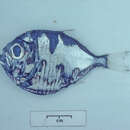en
names in breadcrumbs


View data on Catalog of Fishers here.
Dorsal-fin rays (rarely 11) 12; anal-fin rays 16–17; pectoral-fin rays15–16; gill rakers 16–17; vertebrae (rarely 32) 33 (rarely 34). Largest specimens less than 70 mm SL; body broad, tapering rather abruptly into short caudal peduncle; its depth about equal to its length; post-temporal spine short, less than one-fourth the diameter of orbit; dorsal spine short, preopercle spine triangulate; eyes extremely large, their diameter less than seven times into SL; greatest distance between frontal crests (interorbital), greater than length of subcaudal photophore group; abdominal keel scales not extended ventrally; first and third supra-abdominal photophores about even and raised well above second; first supra-anal photophore noticeably lower than second, which is slightly lower than third; jaws large, broad; teeth well developed on posterior vomerine shaft and lower jaw; gill rakers medium; in preservative broad, dark, dorsal bar reaches to midline; light stripe posterior to dorsal bar not reaching to mid-dorsal line; ventral border of dark dorsal pigment only slightly raised above supra-anal photophores; small dark pigment spots on lateral midline.
Post-temporal spine simple, bearing no basal spines; lateral edge of post-temporal-supracleithrum smooth; keel scales with smooth ventral surfaces; supraanal photophores separate, usually raised well above anal group. Post-temporal spine short, its length less than one-fourth the diameter of orbit; anal photophore number 7 to 9 (occasionally 10); body robust, less than 1.9 times body depth; first supra-anal photophore markedly lower than second. Teeth present on posterior vomerine shaft; second supra-anal photophore lower than third; supra-abdominal photophores symmetrical, first not markedly raised above third. Gill rakers 16 to 17; light stripe behind dark pigment bar not extending to mid-dorsal line; ventral border of dark dorsal pigment not markedly raised above supra-anal photophores.
Southwest Pacific, off Sothern Australia and New Zealand.
Baird RC. 1971. The Systematics, Distribution, and Zoogeography of the Marine Hatchetfishes (family Sternoptychidae). Bulletin of the Museum of Comparative Zooology 142(1):1–128.
Baird RC. 1971. The Systematics, Distribution, and Zoogeography of the Marine Hatchetfishes (family Sternoptychidae). Bulletin of the Museum of Comparative Zooology 142(1):1–128.
To about 70 mm SL.
Off New Zealand, 36°50'S, 176°10'E.
Holotype: NMNZ P.4861 [orig. 4802].
Polyipnus kiwiensis, commonly known as the kiwi hatchetfish, is a species of ray-finned fish in the genus Polyipnus. They live in the Tasman Sea off Australia and New Zealand.[1][2] They are carnivores.[2]
{{cite web}}: CS1 maint: url-status (link) Polyipnus kiwiensis, commonly known as the kiwi hatchetfish, is a species of ray-finned fish in the genus Polyipnus. They live in the Tasman Sea off Australia and New Zealand. They are carnivores.